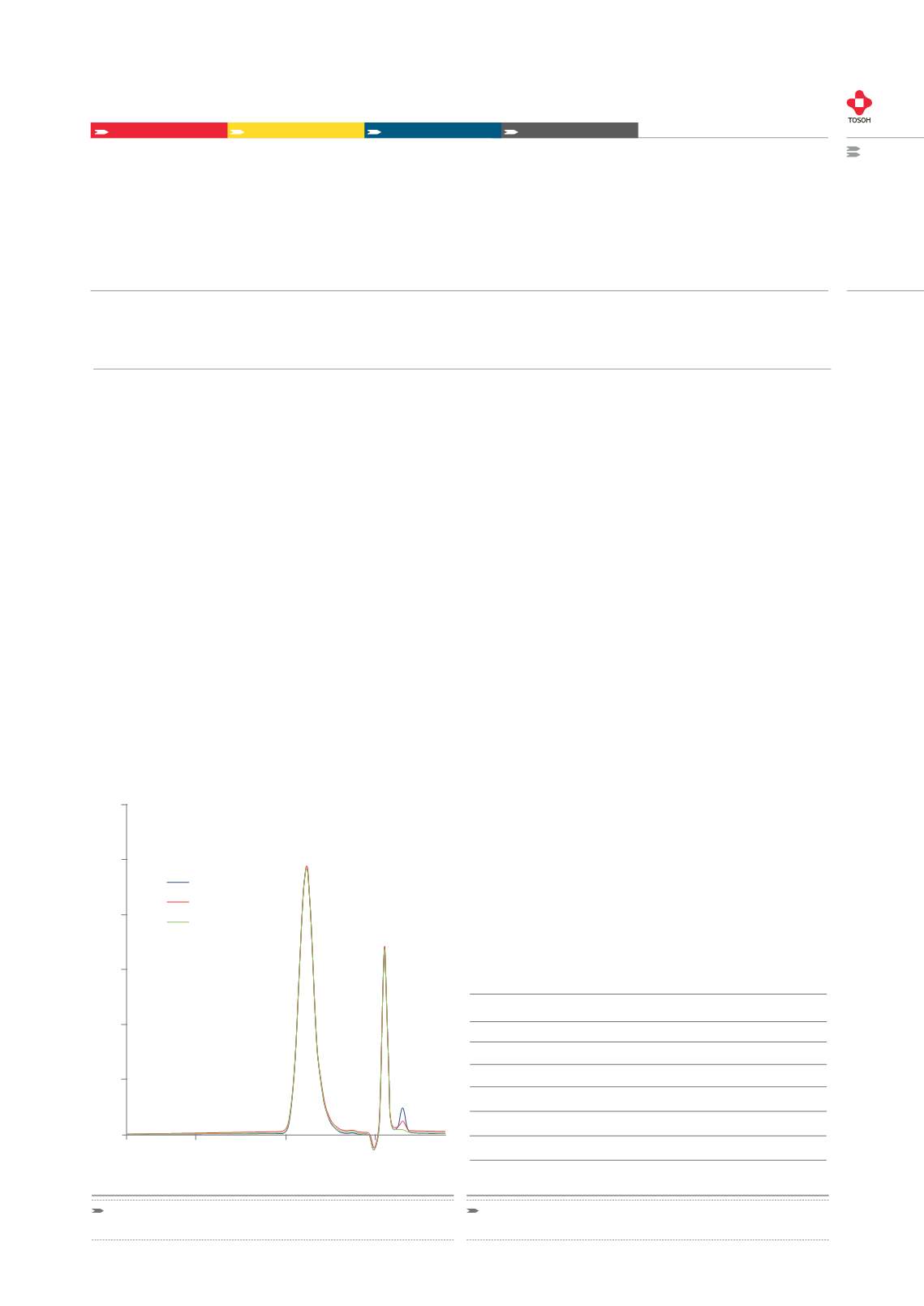
TOSOH
CUSTOMER MAGAZINE
The polypropylene market is one of the largest and most versatile
polymer markets today with over 50 million tons produced annually
and sold into a wide variety of household and industrial applications.
The variety of products requires versatility in mechanical, thermal and
chemical properties. For this reason, depending upon the application,
three major categories of polypropylene exist: homopolymer, block
copolymer, and random copolymer. While homopolymer is the ge-
neral purpose grade of polypropylene, block copolymer exhibits en-
hanced impact resistance. Random copolymer is more malleable and
crystal clear and is often used in medical applications and contact lens
production.
The EcoSEC High Temperature GPC System encompassing a dual
flow refractive index detector was used to perform GPC analysis of
a polymer sample using a series of TSKgel high temperature GPC
columns. The polypropylene random copolymer (300 µL Injection
volume) was analyzed at 140 °C and a flow rate of 1 mL/min using
two TSKgel GMH
HR
-H(20)HT2 columns (20 μm 7.8 × 300 mm) and a
trichlorobenzene (200 ppm butylated hydroxyl toluene (BHT) added
mobile phase. The number-, weight- and z-average molar mass va-
lues (M
n
, M
w
, and M
z
) and polydispersity index, PDI, were calculated
for a polypropylene equivalent via EcoSEC software by applying a
Mark-Houwink constant. The obtained values are given in the table
below. The figure below shows an overlay of three runs.
The reproducibility and reliability of the method were shown through
both the very low variation in sample retention and superb baseline
stability observed when overlaying three consecutive injections of the
sample. The enhanced thermal, flow rate and dual flow RI detector
signal stability of the EcoSEC High Temperature GPC System in com-
bination with the excellent resolving power of the TSKgel GMH
HR
-H
(20) HT2 high temperature GPC columns produce reliable and highly
reproducible data for high temperature GPC analysis.
GPC ANALYSIS OF POLYPROPYLENE RANDOM
COPOLYMERS
UNDERSTANDING A POLYMER IS THE KEY TO THE DEVELOPMENTS OF INNOVATIVE PRODUCTS. MOST OF THE POLYMER PROPERTIES
ARE ASSOCIATED WITH THE MOLECULAR WEIGHT DISTRIBUTION AND AVERAGE MOLECULAR WEIGHTS. GPC IS THE ONLY CHARACTE-
RIZATION TECHNIQUE USED TO DETERMINE BOTH THE MOLECULAR WEIGHT DISTRIBUTION AND THE AVERAGE MOLECULAR WEIGHTS
OF POLYMERS. THEREFORE, CHARACTERIZATION OF POLYMERS USING GPC IS HIGHLY REQUIRED TO TAILOR THE POLYMER PROPERTIES
ACCORDING TO THE APPLICATION. THE ARTICLE SHOWS HOW TOSOH CAN SUPPORT TO TAILOR THE PROPERTIES OF YOUR POLYMER.
07
APPLICATION
HIGH TEMPERATURE GPC
0
10
20
15
Retention time (minutes)
0
20
40
60
80
100
120
Sample 1
Sample 2
Sample 3
Detector response [mV]
FIGURE:
REFRACTIVE INDEX GPC ELUTION PROFILE OF 3 CONSECUTIVE IN-
JECTIONS OF A POLYPROPYLENE RANDOM COPOLYMER SAMPLE (PP EQUIVALENT)
TABLE:
MOLAR MASS AVERAGES AND POLYDISPERSITY INDEX OF THE POLY-
PROPYLENE RANDOM COPOLYMER SAMPLE (PP EQUIVALENT)
1
2
3
Average
STDEV
CV%
Injection
number
16.532
16.527
16.548
16.537
0.011
0.066
Retention time
(minutes)
54380
54153
54027
54187
179
0.33
Mn
(g/mol)
145630
145548
145195
145458
231
0.16
Mw
(g/mol)
286074
289290
286331
287232
1787
0.62
Mz
(g/mol)
2.678
2.688
2.687
2.684
0.001
0.200
PDI
(Mw/Mm)


